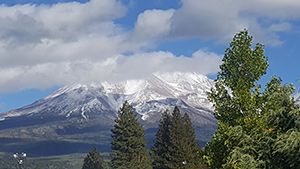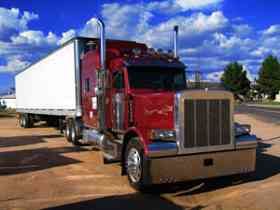What Is Your Preferred Method Of Chaining Up?
Topic 16690 | Page 1
Laying the chain OVER THE TIRE usually works better - because you are 90% on and aligned. All you have to do is move the truck to roll over the "gap" and finish securing.
Keep in mind - when I was taught this (and when all the You-Tube vids were shot) it was a nice sunny day - in a nice open space.
YOU will be doing this (for real) in cold, damp, dreary (likely dark) freezing your butt off, getting your shoes soaked and wishing you were ANYWHERE ELSE but the chain-up area on the side of the road before Donner Pass.
Another tip is to set ALL THE REQUIRED CHAINS at the SAME TIME - roll truck and go around to secure the chains - as in, don't do one tire, move to the next, roll forward, etc. - you'll run out of room to roll forward - as you aren't the only guy in the chain-up area doing this. Remember to bungee, remember to drive slow and not spin the drives (and throw the chains off).
Most folks would prefer to NOT CHAIN and wait it out - most COMPANIES would also prefer you not chain - unless you need to use them to get to safe haven (as in stuck on the highway).
Rick

Several of the people i have talked to have said the same thing, if it's bad enough to chain, it's bad enough to shut down. i don't think my company had the policy to shut down unless we feel unsafe. i'll take it on a case by case basis, but since ive never chained up before, i think maybe ill have to do a few dry runs just so I see how it goes.
thanks for the reply.
At my company the general policy is if chaining is required then we are to shut down. About as far west as we go is Denver.. So no Donner here.
My preferred method is to keep them on the hanger and sit at the truck stop haha. Actually still need to learn how to throw iron just in case I find myself in that situation.
Rick says:
Laying the chain OVER THE TIRE usually works better - because you are 90% on and aligned. All you have to do is move the truck to roll over the "gap" and finish securing.
I agree 100%. That's how I was taught by multiple people, including in our actual chaining class at Swift (where we went out to a truck and actually practiced it). It works pretty well the times I had to do it for real out here. Still sucks though--I remember having to chain up in freezing cold weather in the middle of nowhere along I70 in the dark with snow blowing all over the place, and thinking "Why the hell did I pick this job?" Haha. I've never tried it the other way, but I'd think it would get alot more complicated. Just curious, how did they use that method on the tandems? Chain the front by rolling forward, then roll backwards to chain the back tires on the tandems?
By the way, not saying this to you Sambo, but to other newbies reading this. Don't be like the guys at the truck stop or terminal who say they don't need to know how to chain up since they're gonna shut down as soon as it gets bad. You STILL NEED TO KNOW HOW to chain up. It's completely fine and often advisable to shut down when chaining is required, but you won't always know beforehand. You could be traveling I70 in CO and it suddenly starts starts snowing like crazy and the signs start flashing telling you to chain up. You are not allowed to shut down in the chain-up areas and often troopers will sit right next to them. I don't know firsthand if this is the case, but my trainer told me they ticket drivers for shutting down in the chain-up areas instead of chaining up and moving along. I'm inclined to believe him since they have to keep those areas open for drivers to chain up.
So what are you going to do? Bypass the chain-up area to head to the nearest, probably full-to-the-seams truck stop? If you don't get caught ($500 fine in CO last time I checked), just hope you don't wreck on the way there. In CO if you end up blocking traffic because you slipped without chains on (when the chain law is in effect), they fine you $1000 (last time I checked) for that, AND they tack on the normal fine for not chaining up in the first place. Not to mention you're driving an "80,000 lb death machine" as we like to call it around here, so let's hope you don't jackknife and kill someone.
Sorry for the rant. Lately I have been spending too much time at terminals, the home of complainers and know-it-all, wet-behind-the-ears newbies who actually know jack ****. Don't be like them. Be like Sambo, who wants to know the PROPER way to chain up and is PREPARING NOW.
Terminal:
A facility where trucking companies operate out of, or their "home base" if you will. A lot of major companies have multiple terminals around the country which usually consist of the main office building, a drop lot for trailers, and sometimes a repair shop and wash facilities.
Tandems:
Tandem Axles
A set of axles spaced close together, legally defined as more than 40 and less than 96 inches apart by the USDOT. Drivers tend to refer to the tandem axles on their trailer as just "tandems". You might hear a driver say, "I'm 400 pounds overweight on my tandems", referring to his trailer tandems, not his tractor tandems. Tractor tandems are generally just referred to as "drives" which is short for "drive axles".
Tandem:
Tandem Axles
A set of axles spaced close together, legally defined as more than 40 and less than 96 inches apart by the USDOT. Drivers tend to refer to the tandem axles on their trailer as just "tandems". You might hear a driver say, "I'm 400 pounds overweight on my tandems", referring to his trailer tandems, not his tractor tandems. Tractor tandems are generally just referred to as "drives" which is short for "drive axles".
HOS:
Hours Of Service
HOS refers to the logbook hours of service regulations.OWI:
Operating While Intoxicated
Omg... Read the title and so many things came to mind hahaha
I agree about the chaining how to. My codriver said he would teach me.. But first i have to remember to get a set of chains from our shop in cedar rapids.. I realized that on 2 of the 3 occaisions ive been to Drnver in the last 10 months.. I broke chain laws twice because ive never put any in the truck.. Once in April and again in late September.
MUST remember to requesfchains...bad me.
TWIC:
Transportation Worker Identification Credential
Truck drivers who regularly pick up from or deliver to the shipping ports will often be required to carry a TWIC card.
Your TWIC is a tamper-resistant biometric card which acts as both your identification in secure areas, as well as an indicator of you having passed the necessary security clearance. TWIC cards are valid for five years. The issuance of TWIC cards is overseen by the Transportation Security Administration and the Department of Homeland Security.

Remember, you throw chains on to get out of trouble not into trouble. That said, I chain over the top. I kept the plastic from my mattress to put on the ground when I need to hook on the back side. Also, I use my 5th wheel pull bar to pull the chain towards me. It seems to go quicker for me.
Omg... Read the title and so many things came to mind hahaha
You Dirty Girl!


New Reply:
New! Check out our help videos for a better understanding of our forum features

















Preview:








 TT On Facebook
TT On Facebook
ive watched some videos and ive seen 2 different methods so far. one was to lay the chain across the top of the tire, then roll forward a little and secure the chain. The other was to lay the chain on the ground behind the tire, then back up over the chain and then secure the chain.
From you experienced folks here, have you found that one way works better than the other, or one is easier than the other? Or does it not matter?